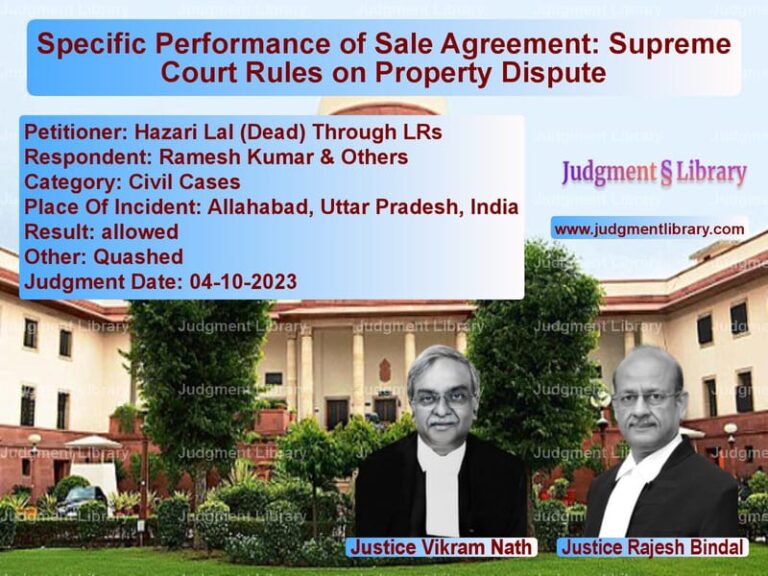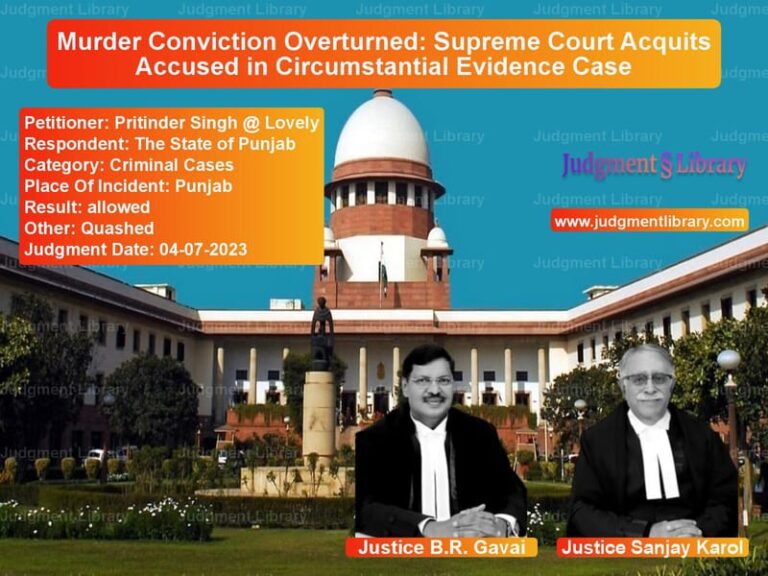Joint Liability in Criminal Law: Supreme Court Clarifies Section 34 IPC
The case of Ramesh Alias Dapinder Singh vs. State of Himachal Pradesh is a significant ruling by the Supreme Court of India concerning the application of Section 34 of the Indian Penal Code (IPC). The case revolves around the principle of joint liability in a criminal act and whether the appellant shared a common intention with his co-accused in committing the offense.
The Supreme Court’s ruling reaffirmed the necessity of proving shared intent beyond mere presence at the crime scene. The decision sets a precedent on how courts should interpret vicarious liability under Section 34 IPC when multiple individuals are accused of a crime.
Background of the Case
The case originated from an incident that took place on March 18, 2014, in Himachal Pradesh. The appellant, Ramesh Alias Dapinder Singh, was accused alongside two others of committing a murder due to an ongoing family dispute.
Read also: https://judgmentlibrary.com/supreme-court-modifies-sentencing-in-karnataka-kidnapping-case/
According to the prosecution, the complainant, Sukhwinder Singh, had previously married Puja Devi, who was related to one of the accused. This led to animosity within the family, resulting in an altercation on the night of the incident.
The key timeline of the case:
- March 18, 2014: The complainant, along with his friends, visited his maternal grandmother’s house.
- March 18, 2014, 8:30 PM: The complainant’s maternal uncles, Sadhu Singh and Nirmal Singh, started an argument.
- March 18, 2014, 10:30 PM: A physical fight ensued between the complainant’s group and the accused.
- March 18, 2014, 11:00 PM: The accused allegedly assaulted the victim, Daljit Singh, leading to his death.
- March 19, 2014: FIR was registered against the accused under Sections 302, 323, and 324 IPC.
Legal Issues Raised
1. Whether Section 34 IPC Applied to the Appellant
The primary legal question was whether Ramesh, who was present at the scene, shared a common intention with the co-accused.
2. Inconsistencies in Witness Testimonies
The defense argued that key prosecution witnesses, PWs 1 and 7, provided conflicting accounts of the crime.
3. Validity of Eyewitness Testimony
The prosecution relied on Sukhwinder Singh’s (PW1) testimony, while another eyewitness, Kulwinder Singh (PW7), did not support the prosecution’s case.
Supreme Court’s Observations
The Supreme Court analyzed the evidence and noted key inconsistencies:
- The appellant was present at the scene but was not seen actively participating in the murder.
- There was no direct evidence proving that the appellant intended to kill the victim.
- The prosecution failed to prove beyond doubt that the appellant shared a common intention with the co-accused.
- The testimony of PW7 contradicted key aspects of the prosecution’s case.
Referring to the principle laid down in T.T. Antony v. State of Kerala and Dharam Pal v. State of Haryana, the Court reiterated that an accused must have actively participated in the crime to be convicted under Section 34 IPC.
Final Verdict
The Supreme Court allowed the appeal and modified the conviction:
- The appellant was acquitted of charges under Sections 302 and 324 IPC.
- The appellant was convicted under Section 323 IPC for voluntarily causing hurt.
- The appellant was sentenced to the period already undergone in custody.
- The appellant was ordered to be released immediately unless required in another case.
Implications of the Judgment
This ruling has important implications for criminal law:
- Section 34 IPC requires proof of common intention. Mere presence at the crime scene does not imply guilt.
- Judicial scrutiny of witness testimonies is crucial. Courts must ensure that evidence is reliable before convicting an accused.
- Preventing wrongful convictions. The ruling prevents innocent individuals from being held liable for crimes they did not actively participate in.
- Protection of fundamental rights. The judgment reinforces the right to a fair trial under Article 21 of the Constitution.
The ruling ensures that criminal liability is assigned only when there is clear proof of intent, upholding the principles of justice and fairness.
Petitioner Name: Ramesh Alias Dapinder Singh.Respondent Name: State of Himachal Pradesh.Judgment By: Justice Uday Umesh Lalit, Justice K.M. Joseph.Place Of Incident: Himachal Pradesh.Judgment Date: 22-03-2021.
Don’t miss out on the full details! Download the complete judgment in PDF format below and gain valuable insights instantly!
Download Judgment: ramesh-alias-dapinde-vs-state-of-himachal-pr-supreme-court-of-india-judgment-dated-22-03-2021.pdf
Directly Download Judgment: Directly download this Judgment
See all petitions in Bail and Anticipatory Bail
See all petitions in Fraud and Forgery
See all petitions in Attempt to Murder Cases
See all petitions in Judgment by Uday Umesh Lalit
See all petitions in Judgment by K.M. Joseph
See all petitions in partially allowed
See all petitions in Modified
See all petitions in supreme court of India judgments March 2021
See all petitions in 2021 judgments
See all posts in Criminal Cases Category
See all allowed petitions in Criminal Cases Category
See all Dismissed petitions in Criminal Cases Category
See all partially allowed petitions in Criminal Cases Category







